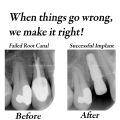Restorative Care
 Restorative Care inSan Francisco, CA
Restorative Care inSan Francisco, CA
- Tooth Colored Fillings
In the past, cavities could only be treated with unsightly metal fillings that are alloys for silver and mercury. These fillings, especially when close to the front of the mouth, are highly noticeable and unaesthetic. Sometimes, the filling is so large that it causes discoloration of the entire tooth. These fillings (or restorations) often weaken teeth due to the large amount of the original tooth that has to be removed. Also there is a risk of Mercury poisoning that is used in the filling. Modern dentistry has increasingly turned to Tooth colored or composite fillings as a strong, safe and more natural looking alternative. Composite fillings utilize a soft white plastic substance that is hardened with a blue light.
- Crowns and Bridges
When a tooth is fractured, has a large old filling, or is severely damaged by decay, your dentist may recommend the placement of a crown. Crowns strengthen and protect the remaining tooth structure and can improve the appearance of your smile.
Types of crowns include the full porcelain crown, the porcelain-fused-to-metal crown (precious & non-precious) and the all-metal crown.
Fitting a crown requires at least two visits to the dentist’s office. Initially, the Dentist removes decay and shapes the tooth; makes an impression and fits a temporary or transitional crown of plastic or metal. In a subsequent visit, the dentist removes
the temporary crown, fits and adjusts the final crown and cements the crown into place.
BRIDGES: Few incidents have greater impact on dental health and personal appearance than tooth loss. When one or more teeth are missing, the remaining teeth can drift out of position, which can lead to a change in the bite, the loss of additional teeth, decay and gum disease. When tooth loss occurs, your dentist may recommend the placement of a bridge. A bridge is one or more replacement teeth anchored by one or more crowns on each side.
It is a field of dentistry that treats the root canal system. When decay extends to the pulp or the nerve inside the tooth, the person almost always experiences spontaneous throbbing pain. The pain increases at night and is aggravated with cold & sweet foods. The Dentist relieves the pain and pressure symptoms by treating the root canal system which houses the tooth nerve or pulp.
Over time, people’s teeth tend to naturally deteriorate. When a tooth has deteriorated substantially, it often needs to be extracted; and when multiple teeth are extracted, dentures may be the most appropriate solution. Dentures can create a natural and healthy looking set of teeth. In addition, a properly fitting set of dentures can greatly enhance your smile and sense of self-esteem.
Other products and services:
Products and Services of other companies:
- +1 (415) 468-1777
- 9 Silliman St. Ste 1 San Francisco, CA 94134
- jmwdental.com/









